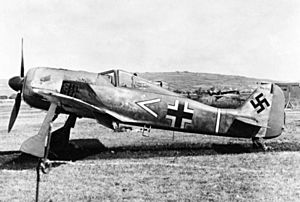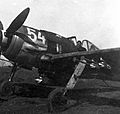Focke-Wulf Fw 190 facts for kids
Quick facts for kids Fw 190 |
|
|---|---|
 |
|
| Fw 190A-3 of Stab. 7./JG2, June 1942. | |
| Role | Fighter |
| Manufacturer | Primarily Focke-Wulf Flugzeugbau AG, but also AGO, Arado, Fieseler, Mimetall, Norddeutsche Dornier and others |
| Designer | Kurt Tank |
| First flight | 1 June 1939 |
| Introduction | August 1941 |
| Retired | 9 May 1945 (Luftwaffe) 1949 (Turkey) |
| Primary users | Luftwaffe Hungarian Air Force Turkish Air Force |
| Produced | 1941–45; 1996: 16 reproductions |
| Number built | Over 20,000 |
| Variants | Ta 152 |
The Fw 190 was a powerful German fighter aircraft used during World War II. It was built by Focke-Wulf and first flew in 1939. This plane became active in 1941. Even though it didn't look very sleek, it could fly incredibly fast, reaching speeds of 408 miles per hour (653 kilometers per hour). Pilots sometimes called it the Shrike or the Butcher Bird.
Contents
The Fw 190 in Action
The Fw 190 was a very important plane for the Luftwaffe, which was Germany's air force. It was known for being strong and able to take a lot of damage. This made it a tough opponent for Allied planes.
An Accidental Landing
In 1942, a Luftwaffe pilot named Armin Faber made a big mistake. He accidentally landed his Fw 190 at a British airfield. This was a huge deal for the British. They were able to study the plane closely. This helped them learn its secrets and find ways to fight against it.
How the Fw 190 Performed
The Fw 190 was a strong and fast aircraft. It was 29 feet (8.84 meters) long. Its wings stretched 34 feet 5.5 inches (10.49 meters) wide. The plane stood 13 feet (3.96 meters) high.
When empty, it weighed 7,055 pounds (3,200 kilograms). When ready for flight, it weighed 10,800 pounds (4,900 kilograms). It could fly as high as 37,400 feet (11,410 meters). It could also travel 560 miles (900 kilometers) without needing more fuel.
Fw 190 vs. Bf 109
The Fw 190 was often compared to another famous German fighter, the Bf 109. The Fw 190 was about 1500 kg heavier than the Bf 109. It was also a bit faster. For example, the Fw 190 A-8 model was 16 kph faster than the Bf 109 G-6.
However, the Bf 109 could climb faster. It climbed at 17 meters per second, while the Fw 190 climbed at 15 meters per second. The Fw 190 had much stronger weapons. It carried two machine guns above the engine and four cannons in its wings. The Bf 109 usually had only one cannon and two machine guns.
Related pages
Images for kids
-
The Flying Heritage & Combat Armor Museum's airworthy Fw 190A-5, WkNr. 151 227, on indoor display between flights.
See also
 In Spanish: Focke-Wulf Fw 190 para niños
In Spanish: Focke-Wulf Fw 190 para niños

















